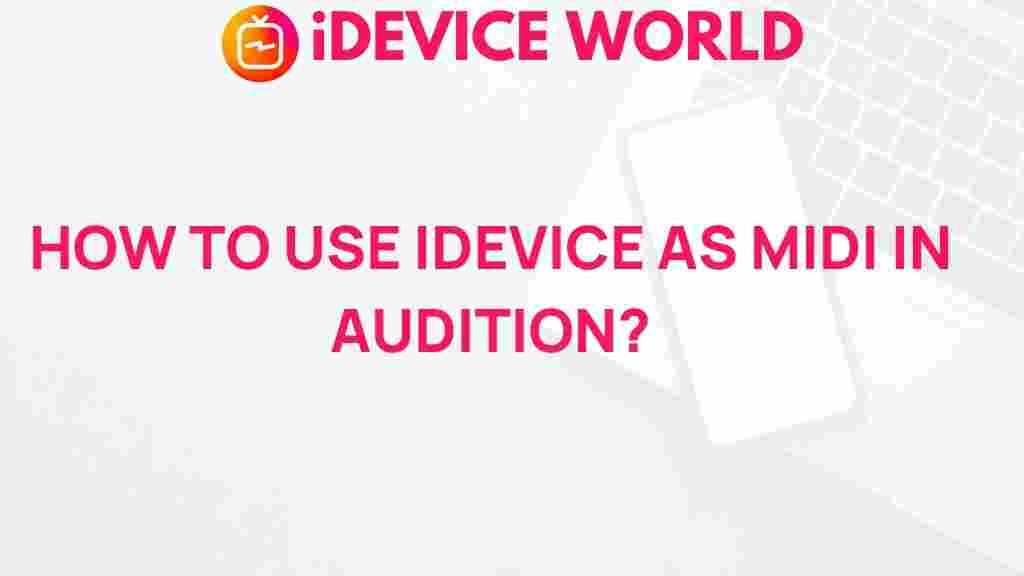Unleash Your Creativity: Transform Your iDevice into a MIDI Controller for Adobe Audition
In today’s digital age, creativity knows no bounds, especially for music producers and audio engineers. If you are looking for ways to enhance your workflow and creativity in Adobe Audition, you might want to consider turning your iDevice into a MIDI controller. This article will guide you through the process of transforming your iDevice into a powerful tool for music production, making it easier to unleash your creativity.
Why Use an iDevice as a MIDI Controller?
Many audio professionals and hobbyists are exploring innovative ways to enhance their production capabilities. By using your iDevice, such as an iPhone or iPad, as a MIDI controller, you can:
- Access flexibility: Control various functions in Adobe Audition remotely.
- Enhance your creativity: Utilize your device’s touch screen for more intuitive control.
- Save money: Use existing devices instead of purchasing expensive hardware controllers.
Getting Started: Requirements
Before diving into the transformation process, ensure you have the following:
- Your iDevice (iPhone, iPad, etc.)
- Adobe Audition installed on your computer
- A MIDI-compatible app on your iDevice (such as Lemur or TouchOSC)
- A Wi-Fi connection to connect your iDevice and computer
Step-by-Step Process to Transform Your iDevice into a MIDI Controller
Step 1: Install MIDI Controller App on Your iDevice
Start by downloading a MIDI controller app from the App Store. Some popular choices include:
Step 2: Set Up Your iDevice and Computer
Ensure both your iDevice and computer are connected to the same Wi-Fi network. This step is crucial for seamless communication between the two devices.
Step 3: Configure Adobe Audition
Next, open Adobe Audition and navigate to the preferences:
- Go to Edit → Preferences → MIDI.
- Enable MIDI device input by checking the appropriate box.
- Make sure to select the MIDI controller app as an input device.
Step 4: Create Your MIDI Layout
Within your MIDI controller app, create a layout that suits your workflow. This can include sliders, buttons, and faders to control various aspects of Adobe Audition:
- Design sliders for volume control.
- Add buttons for play, stop, and record functionalities.
- Customize your layout based on your production needs.
Step 5: Connect the iDevice to Adobe Audition
Once your layout is ready, go back to your iDevice and ensure the MIDI app is running. Connect the app to Adobe Audition by selecting your computer’s IP address within the app’s settings. Your iDevice should now communicate with Audition!
Troubleshooting Tips
While transforming your iDevice into a MIDI controller is straightforward, you may encounter some issues. Here are some troubleshooting tips:
- Connection Issues: Ensure both devices are on the same Wi-Fi network. Restarting the app and Adobe Audition can help.
- Input Not Recognized: Double-check the MIDI input settings in Adobe Audition preferences.
- Latency Problems: If you experience lag, try adjusting the buffer size in Audition’s audio settings.
Advanced Customizations
Once you are comfortable with the basic setup, consider exploring advanced features:
- Macros: Create complex control setups that automate multiple functions with a single button.
- Custom Feedback: Implement visual feedback on your iDevice for improved performance.
- Integration with Other Software: Utilize your iDevice as a MIDI controller across other DAWs or software.
Conclusion
Transforming your iDevice into a MIDI controller for Adobe Audition is a fantastic way to enhance your music production workflow. With just a few simple steps, you can turn your existing technology into a powerful tool that boosts your creativity and efficiency. Whether you’re a seasoned pro or just starting, this method offers endless possibilities for your audio projects. Embrace the flexibility of your iDevice and unleash your creativity today!
For more tips on optimizing your audio production experience, check out our comprehensive guide on music software and hardware. Happy creating!
This article is in the category Guides & Tutorials and created by iDeciveWorld Team
